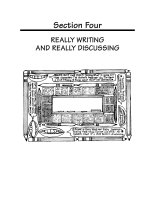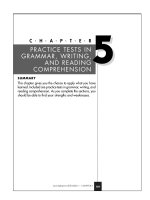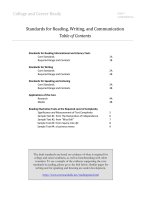REALLY WRITING AND REALLY DISCUSSING
Bạn đang xem bản rút gọn của tài liệu. Xem và tải ngay bản đầy đủ của tài liệu tại đây (250.67 KB, 30 trang )
Section Four
REALLY WRITING
AND REALLY DISCUSSING
85. IDIOMS (PART ONE)
An idiom is an untranslatable expression. “To bury the hatchet,” for example, means “to
make peace.” On a separate sheet of paper, write what you think is each expression’s
meaning. Then write how you think these ten idioms became part of the English language.
The supposed source of each idiom is given in parentheses. Of course, there may be other
supposed sources!
1. Bury the hatchet. (Native Americans)
2. Break the ice. (skating)
3. The whole nine yards. (aircraft)
4. Swimming upstream. (salmon)
5. Mind your p’s and q’s. (pints and quarts)
6. It didn’t pan out. (searching for gold)
7. By hook or by crook. (boating/crocheting)
8. Saved by the bell. (boxing)
9. Turn over a new leaf. (a page in a book)
10. Barking up the wrong tree. (hunting with hounds)
© 2002 by John Wiley & Sons, Inc.
111
NAME ______________________________________________ DATE _____________________ PERIOD ______________
86. IDIOMS (PART TWO)
An idiom is an untranslatable expression. For example, “to jump on the bandwagon” means
to support an already popular cause or idea. On a separate sheet of paper, write what you
think is the expression’s meaning. Then write how you think these ten idioms became part of
the English language. The supposed source of each idiom is given to you. Of course, there
could be other supposed sources!
1. Jump on the bandwagon. (baseball cancellation)
2. Rain check. (political campaigns)
3. Chip on your shoulder. (fighting)
4. Once in a blue moon. (two full moons in a month)
5. On the Q.T. (abbreviation for quiet)
6. Red-carpet treatment. (royalty)
7. Get down to brass tacks. (fabric measurement)
8. White elephant. (gift giving)
9. Get into the swing of things. (pendulum of a clock)
10. Don’t put all your eggs in one basket. (farmers)
© 2002 by John Wiley & Sons, Inc.
112
NAME ______________________________________________ DATE _____________________ PERIOD ______________
TEAMFLY
Team-Fly
®
87. EXAMINING EMILY
Emily Dickinson (1830–1886) is one of America’s most respected (and puzzling) poets. Many
of her poems have inspired great thought and discussion. Her poem “Number 315,” which
has been distributed by your teacher, is no exception.
First, on the appropriately numbered line, paraphrase each of the poem’s 14 lines. Then
the real question is “Who or what is the He?” in the poem. On a separate sheet of paper,
answer that exact question. Give specific examples from the poem to support your opinion.
Discuss your answers with your classmates.
1. ______________________________________________________________________
2. ______________________________________________________________________
3. ______________________________________________________________________
4. ______________________________________________________________________
5. ______________________________________________________________________
6. ______________________________________________________________________
7. ______________________________________________________________________
8. ______________________________________________________________________
9. ______________________________________________________________________
10. ______________________________________________________________________
11. ______________________________________________________________________
12. ______________________________________________________________________
13. ______________________________________________________________________
14. ______________________________________________________________________
© 2002 by John Wiley & Sons, Inc.
113
NAME ______________________________________________ DATE _____________________ PERIOD ______________
88. WHAT IS A GOOD BOOK?
In an interview, Ernest Hemingway, the author of The Old Man and the Sea, The Sun Also
Rises, and other novels and short stories, once said, ”All good books are alike in that they are
truer than if they had really happened and after you are finished reading one you will feel
that all that happened to you and afterwards it all belongs to you; the good and the bad, the
ecstasy, the remorse, and sorrow, the people and the places and how the weather was.” On
the lines provided, answer the following questions.
1. Define ecstasy. __________________________________________________________
2. Define remorse. __________________________________________________________
3. Paraphrase Hemingway’s quote. ______________________________________________
4. Do you agree or disagree with the quote? Why? ________________________________
5. Select a novel you have read and—on another sheet of paper—explain how Hemingway’s
quote is appropriate or inappropriate regarding that book.
6. Now that you know what Hemingway feels is a “good book,” what do you feel is a “good
book”? Write your answer on another sheet of paper.
© 2002 by John Wiley & Sons, Inc.
114
NAME ______________________________________________ DATE _____________________ PERIOD ______________
89. WHERE DID IT COME FROM?
Have you ever thought about the origins of certain everyday expressions? Where did
“lead one by the nose” or “give me five” start? How about “sitting pretty” or “in the
red”?
Today is your chance to devise your own explanations of how the following ten
expressions became part of our language. On a separate sheet of paper, write a paragraph on
how you think each expression came into existence. Share your “story behind the
expression” with your classmates. If time allows, look up the meaning and accepted story
behind these expressions. How close did you and your classmates come to the real story?
1. lead by the nose
2. give me five
3. sitting pretty
4. in the red
5. hit the hay
6. salt of the earth
7. keep your ear to the ground
8. get off the hook
9. horse of a different color
10. from soup to nuts
© 2002 by John Wiley & Sons, Inc.
115
NAME ______________________________________________ DATE _____________________ PERIOD ______________
90. TELL THE STORY BEHIND IT
Each expression below had to have a beginning, a place and time where it started. Your job is
to make up “the story behind the word.” On the lines following the four expressions, write
your ideas as to how the expression began. Your teacher will then tell you the generally
accepted story behind each expression.
1. bite the bullet ____________________________________________________________
2. back to square one ______________________________________________________
3. double-cross ____________________________________________________________
4. bring home the bacon ____________________________________________________
© 2002 by John Wiley & Sons, Inc.
116
NAME ______________________________________________ DATE _____________________ PERIOD ______________
91. THREE CHARACTERS
Here are character descriptions from three different literary works. Each character is
described using effective diction (word choice) and syntax (word and sentence placement).
First, look up any new vocabulary words found in the three descriptions. Then circle the
words that contribute to a greater understanding of each character. Lastly, on another sheet
of paper, describe a character, real or fictional, using the techniques employed by
Hemingway, Schaefer, or Dickens. Discuss your thoughts with your classmates.
For Whom the Bell Tolls by Ernest Hemingway
“The young man, who was tall and thin, with sun-streaked fair hair, and a wind-and-sun-
burned face, who wore the sun-faded flannel shirt, a pair of peasant’s trousers and rope-
soled shoes, leaned over, put his arm through one of his leather pack straps and swung the
heavy pack against his back. His shirt was still wet from where the pack had rested.”
Shane by Jack Schaefer
“He was clean-shaven and his face was lean and hard and burned from high forehead
to firm, tapering chin. His eyes seemed hooded in the shadow of the hat’s brim. He came
closer, and I could see that this was because the brows were drawn in a frown of fixed and
habitual alertness. Beneath them the eyes were endlessly searching from side and forward,
checking off every item in view, missing nothing. As I noticed this, a sudden chill, I couldn’t
have told why, struck through me there in the warm and open sun.”
A Christmas Carol by Charles Dickens
“Oh! but he was a tight-fisted hand at the grindstone, Scrooge! A squeezing,
wrenching, grasping, scraping, clutching, covetous old sinner. Hard and sharp as flint, from
which no steel had ever struck out generous fire, secret, and self-contained, and solitary as
an oyster. The cold within him froze his old features, nipped his pointed nose, shriveled his
cheek, stiffened his gait, made his eyes red, his thin lips blue, and spoke out shrewdly in his
grating voice. A frosty rime was on his head and on his eyebrows, and his wiry chin. He
carried his own low temperature always about with him; he iced his office in the dog days;
and didn’t throw it one degree at Christmas.”
© 2002 by John Wiley & Sons, Inc.
117
NAME ______________________________________________ DATE _____________________ PERIOD ______________
92. DRAW THE DESCRIPTIONS
Here is an interesting way to “see” what authors want us to “see.” First, look up any word
whose definition you do not know. Then, on a plain sheet of paper, draw a picture of each
character as described by the author. Discuss your drawings with your classmates.
Slake’s Limbo by Felice Holman
“To begin with, Slake was small. Anyone could beat him for any reason or non-reason,
and did, when they could catch him. But he was wiry and wily, too, and he could often out-
run, tack, back-track, double-back, and finally dodge unseen into the subway, hiding, if
possible, in some nook of the station to save the fare, or riding, if necessary, till things cooled
off and the world above became habitable again. That’s just to begin with.”
The Scarlet Letter by Nathaniel Hawthorne
“The young woman was tall, with a figure of perfect elegance on a large scale. She had
dark and abundant hair; so glossy that it threw off the sunshine with a gleam, and a face
which, besides being beautiful from regularity of feature and richness of complexion, had the
impressiveness belonging to a marked brow and deep black eyes. She was ladylike, too,
after the manner of feminine gentility of those days; characterized by a certain state and
dignity, rather than by the delicate, evanescent, and indescribable grace, (over) which is now
recognized as its indication.”
© 2002 by John Wiley & Sons, Inc.
118
NAME ______________________________________________ DATE _____________________ PERIOD ______________
93. FOR OPENERS (PART ONE)
Here are the openings of three well-known novels. On the lines beneath each opening
excerpt, write what you think is the author’s intended purpose. Is the author establishing
character? setting? conflict? Be prepared to explain your opinions. If you need additional
space, use the back of this sheet.
Kidnapped by Robert Louis Stevenson
“I will begin the story of my adventure with a certain morning early in the month of June,
the year of grace 1751, when I took the key for the last time out of the door of my father’s
house. The sun began to shine upon the summit of the hills as I went down the door; and by the
time I had come as far as the manse, the blackbirds were whistling in the garden lilacs, and the
mist that hung around the valley in the time of the dawn was beginning to arise and die away.”
The Scarlet Letter by Nathaniel Hawthorne
“A throng of bearded men, in sad-colored garments and gray, steeple-crowned hats,
intermixed with women, some wearing hoods, and others bareheaded, was assembled in
front of a wooden edifice, the door of which was heavily timbered with oak and studded with
iron spikes.”
Bless the Beasts and Children by Glendon Swarthout
“In that place the wind prevailed. There was always sound. The throat of the canyon was
hoarse with wind. It heaved through pines and passed and was collected by the cliffs. There
was a phenomenon of pines in such a place. When the wind died in box canyon and in its
wake the air was still and taut, the trees were not. The passing trembled in them, a sough of
loss. They grieved. They seemed to mourn a memory of wind.”
© 2002 by John Wiley & Sons, Inc.
119
NAME ______________________________________________ DATE _____________________ PERIOD ______________
94. FOR OPENERS (PART TWO)
Here are the openings of three well-known novels. On the lines beneath each excerpt, write
what you think is the author’s intended purpose. Is the author establishing character?
setting? conflict? Be prepared to explain your opinions. If you need additional space, use the
back of this sheet.
The Crystal Cave by Mary Stewart
“I am an old man now, but then I was already past my prime when Arthur was crowned
King. The years since then seem to me now more dim and faded than the earlier years, as if
my life were a growing tree which burst to flower and leaf with him, and now has nothing
more to do than yellow to the grave.”
Dracula by Bram Stoker
“Jonathan Harker’s Journal (kept in shorthand) 3rd May. Bistritz—left Munich at 8:35
P
.
M
., on 1st May, arriving in Vienna early next morning; should have arrived at 6:46, but train
was an hour late. Buda-Pesth seems a wonderful place, from the glimpse which I got of it
from the train and the little I could walk through the streets. I feared to go very far from the
station, as we arrived late and would start as near the correct time as possible.”
The Yearling by Marjorie Kinnan Rawlings
“A column of smoke rose thin and straight from the cabin chimney. The smoke was blue
where it left the red of clay. It trailed into the blue of the April sky and was no longer blue but
gray. The boy Jody watched it, speculating. The fire on the kitchen hearth was dying down.
His mother was hanging up pots and pans after the noon dinner. The day was Friday.”
© 2002 by John Wiley & Sons, Inc.
120
NAME ______________________________________________ DATE _____________________ PERIOD ______________









